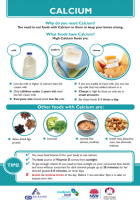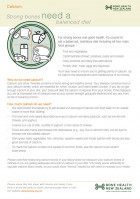Calcium
Key points about calcium
- Calcium is vital for healthy bones and teeth.
- It's also important for muscle and nerve activity in your body, including for your heartbeat.
- Good sources of calcium include dairy foods such as milk, yoghurt and cheese.
- Other food sources include calcium fortified milks – such as soy milk – leafy green vegetables and some nuts.
- A low intake of calcium has been associated with osteoporosis, which weakens your bones and can lead to fractures.

Calcium is a mineral. It's vital for developing and maintaining healthy bones and teeth throughout your life.
A small amount of calcium is absorbed into your blood and is important for muscle and nerve activity in your body, including for your heartbeat.
Eating a diet rich in foods containing calcium is the best way to get enough.

Image credit: Canva
Calcium is stored in your bones
Your skeleton contains 99% of your body’s calcium. Calcium is deposited in your bones until your mid-20s.
- Your bone mass increases about 7-fold from birth to puberty and a further 3-fold during adolescence.
- It then remains stable until about 50 of age in men or until women reach menopause.
- Bones act as a calcium bank. If there's not enough calcium in your diet, your body will take what's needed from your bones for use in other parts of your body.
Calcium deficiency
Calcium deficiency in children will stunt their growth and result in poor quality teeth and bones and an increased risk of fractures. Adults will experience aches and pains, lose height and develop brittle bones (osteoporosis).(external link)
Dairy foods
- Dairy products such as cow’s milk, yoghurt and cheese are the richest source of calcium.
- A glass of milk (250 mL) contains about 300 mg calcium.
- Low and reduced-fat milk and yoghurt are best to help reduce your intake of saturated fat and total energy.
- Goat's and sheep milk have similar nutrition to cow’s milk and are also a good source of calcium.
- Butter, cream, cream cheese and sour cream are made from milk fat so have high levels of saturated fat and are low in protein and calcium.
Other food sources of calcium
- Plant-based milks made from soy, rice, oats or nuts (eg, almonds, cashews) are an alternative to cow’s milk. These milks are not naturally high in calcium. Always look for a product that's had calcium added (at least 120 mg calcium per 100 mL).
- Canned salmon and sardines due to their soft, edible bones.
- Tofu and tempeh (fermented soybean) made from soybeans.
- Dark, leafy, green vegetables such as kale, spinach, cabbage, broccoli and bok choy.
- Nuts and seeds such as Brazil nuts, almonds, hazelnuts, chia seeds, flaxseed, sesame seeds.
-
Fortified foods such as some cereals, oats, breads and other foods which may have calcium added. Check the label to see if they do, as this can help boost your calcium levels.
Note: Foods sources such as spinach, rhubarb, beans, seeds, nuts and whole grains also contain oxalic or phytic acid which reduces the amount of calcium that can be used by the body.
Calcium content of different foods
| Food or drink | Serving size | Calcium content |
| Standard cow's milk | 250 mL (1 cup) | 290 mg |
| Reduced fat cow's milk | 250 mL (1 cup) | 320 mg |
| Calcium fortified cow's milk (eg, Calci plus) | 250 mL (1 cup) | 475 mg |
| Calcium fortified soy and rice-based milk | 250 mL (1 cup) | 325 mg |
| Calcium fortified almond milk | 250 mL (1 cup) | 228 mg |
| Greek yoghurt | 150 g (1 pottle) | 262 mg |
| Edam cheese | 20 g (1 slice) | 188 mg |
| Sardines (tinned with bones) | 2 sardines | 110 mg |
| Mussels | 6 mussels | 136 mg |
| Salmon (tinned with bones) | 57 g (small can) | 154 mg |
| Tofu | 80 g | 168 mg |
| Baked beans | 3/4 cup | 90 mg |
| Taro leaves | 1 cup chopped | 86 mg |
| Spinach, silverbeet, leeks, Chinese cabbage | 1/2 cup cooked | 45 mg |
| Almonds | 30 g | 69 mg |
Here are the recommended dietary intakes (RDIs) of calcium for people of different age groups:
- Babies (0–6 months): 210 mg
- Babies (7–12 months): 270 mg
- Children (1–3 years): 500 mg
- Children (4–8 years): 700 mg
- Children (9–11 years): 1,000 mg
- Children (12–18 years): 1,300 mg
- Adult men (19–70 years): 1,000 mg
- Older adult men (over 70 years): 1,300 mg
- Adult women (19–50 years): 1,000 mg
- Adult women (over 50 years): 1,300 mg
- Pregnant and breastfeeding people (14–18 years): 1,300 mg
- Pregnant and breastfeeding people (19+ years): 1,000 mg
- Children and young people: Calcium is particularly important for children and young people because their bones are growing rapidly.
- Older men and women: Bone loss speeds up with the hormonal changes following menopause and with age. This means women after menopause and men over 70 years of age have higher calcium needs. Weight-bearing exercise and vitamin D (which helps your body to absorb calcium from your diet) also help to maintain bone strength.
- People who exclude dairy: People following a vegan diet or excluding dairy foods due to a milk allergy or lactose intolerance need to carefully include plenty of non-dairy sources of calcium.
- People who smoke, drink excessive amounts of caffeine or have high salt or protein intakes: These can cause calcium loss from your body.
It's best to get calcium from foods because of the other nutrients obtained. However, sometimes when there's not enough calcium in your diet for your body's needs then taking a calcium supplement may be necessary – especially if you're at risk of developing osteoporosis.
If you’re thinking about taking a calcium supplement, talk to your healthcare provider or pharmacist first as it may interact with other medicines you’re taking.
Menopause and calcium supplements
During menopause you have an increased risk of osteoporosis and bone fracture. Read more about osteoporosis.
If you are postmenopausal, a high calcium intake (more than 1,300 mg per day) will slow the rate of bone loss and may reduce the risk of fracture. However, it is not proven that getting your calcium from supplements will have this effect.
There is some evidence suggesting that there may be an increased risk of heart attacks and other cardiovascular problems for postmenopausal women taking calcium supplements. However, the research in this area is inconsistent. It's best to look at food as the first option for increasing your calcium intake and discuss the benefits and risks of calcium supplements with your healthcare provider.
Read more about calcium supplements.
- Include milk, yoghurt and cheese in meals and snacks and aim for 2 to 3 serves per day.
- Choose low and reduced-fat versions to reduce your intake of saturated fat and energy.
- Choose plain yoghurt instead of flavoured or sweetened versions. Have it on top of breakfast, as a snack or dessert.
- Choose non-dairy yoghurt, cheeses and milks, or other food products with added calcium (calcium-fortified). You'll see calcium in the ingredients list and on the nutrition label.
- Have small amounts of raw, unsalted almonds as a healthy snack.
- Make meals with foods containing calcium, such as a green leafy salad with 45 g tinned salmon as a quick lunch.
- Eat a varied diet with food from the 4 food groups which will mean that you are naturally including a wide range of foods containing calcium including dairy foods, vegetables, fruit, nuts, seeds, legumes etc.

Image credit: Canva
Calcium(external link) Nutrition Foundation, NZ
Osteoporosis(external link) Osteoporosis NZ
Calcium and bone health(external link) Healthy Bones Australia
Calcium(external link) Better Health Channel, Australia
Brochures
Calcium factsheet – strong bones need a balanced diet(external link) Bone Health NZ
Calcium factsheet [PDF, 733 KB] Produced by Refugee Collaborative Auckland DHB, NZ English [PDF, 733 KB], Amharic [PDF, 269 KB], Arabic [PDF, 415 KB], Dari [PDF, 374 KB], Karen [PDF, 949 KB], Persian/Farsi [PDF, 740 KB], Somali [PDF, 247 KB], Tamil [PDF, 1 MB]
Tools and calculators
Calcium calculator(external link) International Osteoporosis Foundation (Note: the US Institute of Medicine calcium recommendations are used in this calcium calculator and they're slightly different to New Zealand's recommended dietary intakes – RDIs)
Know your bones bone health assessment tool(external link) Healthy Bones Australia
References
- Nutrient reference values for Australia and New Zealand including recommended dietary intakes(external link) NHMRC, Australia, 2017
- Eating and activity guidelines for New Zealand adults(external link) Health New Zealand | Te Whatu Ora, NZ, 2020
- Calcium(external link) Food Composition Data New Zealand
- Calcium – health professional fact sheet(external link) NZ Formulary
- Liu C, Kuang X, Li K, et al. Effects of combined calcium and vitamin D supplementation on osteoporosis in postmenopausal women – a systematic review and meta-analysis of randomized controlled trials(external link) Food Funct. 2020 Dec 1;11(12):10817-10827
- Behzad H, Hajian-Tilaki K, Babei M. Effectiveness and safety of routine calcium supplementation in postmenopausal women. A narrative review(external link) Diabetes Metab Syndr: Clin Res Rev. 2020;14(4):435–442
- Cormick G, Ciaponni A, Cafferata ML, et al. Calcium supplementation for prevention of primary hypertension(external link) Cochrane Database of Systematic Reviews 2015, Issue 6. Art. No. CD010037.
- Myung SK, Kim HB, Lee YJ, et al. Calcium Supplements and Risk of Cardiovascular Disease: A Meta-Analysis of Clinical Trials(external link) Nutrients 2021;13(2):368
- Calcium Supplements(external link) Australasian Menopause Society
Credits: Healthify editorial team. Healthify is brought to you by Health Navigator Charitable Trust.
Reviewed by: Lily Henderson, Registered Dietitian
Last reviewed:
Page last updated:







